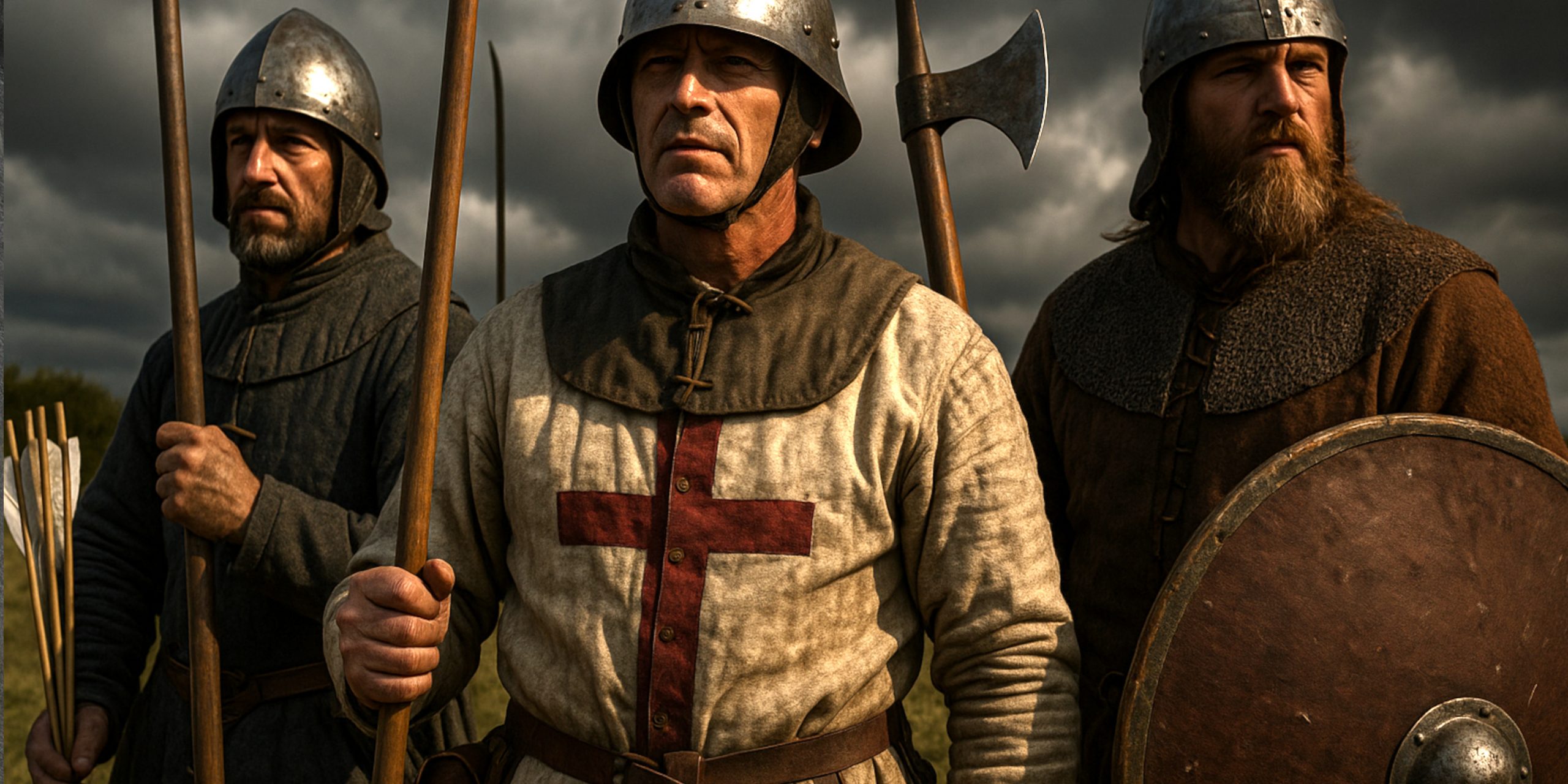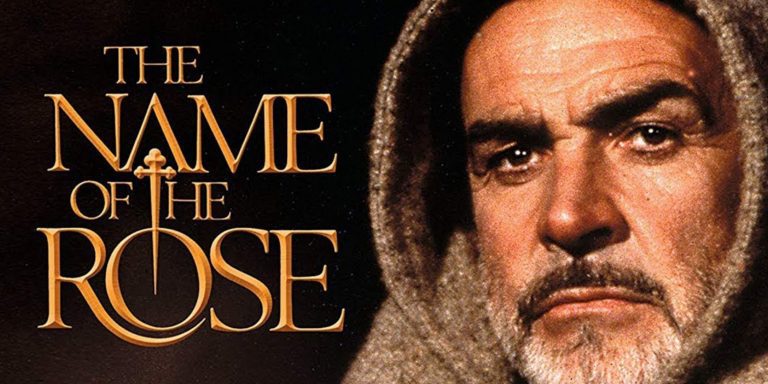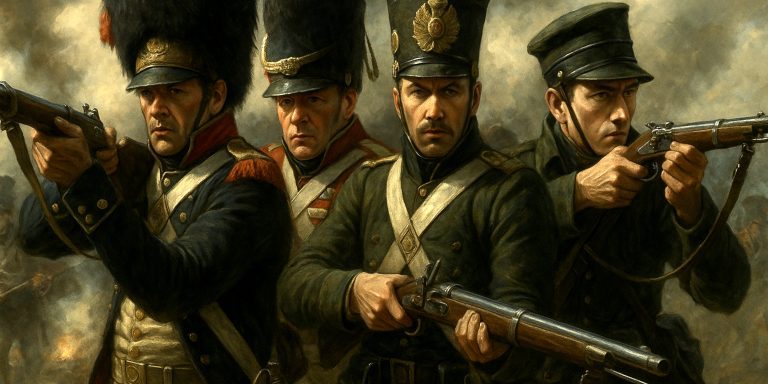
The story of medieval warfare isn’t complete without the men who stood their ground on foot. Infantry defined medieval warfare. They held ground, broke charges, and outlasted knights whose prestige far outweighed their actual contribution. What separates these units isn’t only courage or formation, it’s the weapons they carried and how they used them.
S-Tier: The Game-Changers
English Longbowmen (13th–15th centuries)
Weapons: Yew longbow; bollock dagger for close combat; mallet or lead hammer for finishing blows; wooden stakes for defence.
Battles: Crécy (1346), Poitiers (1356), Agincourt (1415).
Why They Matter: They destroyed the chivalric order with disciplined volleys and lethal range. Though lightly armoured, their training gave them strength rivaling any knight.
Swiss Pikemen (14th–16th centuries)
Weapons: Pike (12–18 ft), Katzbalger short sword, Swiss baselard, halberd for officers.
Battles: Morgarten (1315), Sempach (1386), Marignano (1515).
Why They Matter: Pike formations replaced feudal cavalry as Europe’s decisive weapon. The Katzbalger, short and broad-bladed, served as their sidearm in the crush of melee.
Janissaries (14th–16th centuries)
Weapons: Composite bow, kilij (curved sabre), later matchlock arquebus, dagger.
Battles: Varna (1444), Constantinople (1453), Mohács (1526).
Why They Matter: They combined traditional skill with early firearms, creating the first disciplined standing infantry to successfully merge melee, missile, and gunpowder tactics.
Scottish Schiltron Infantry (13th–14th centuries)
Weapons: Long spear or pike, dirk, claymore (early type XIIa hand-and-a-half sword).
Battles: Stirling Bridge (1297), Bannockburn (1314).
Why They Matter: The Scots proved that courage and formation could overcome cavalry. Their circular and square schiltrons became templates for later pike tactics.
Flemish Guild Militia (13th–14th centuries)
Weapons: Pike, goedendag (club-spear hybrid), arming sword (Type XII) or falchion, crossbow.
Battles: Courtrai (1302), Arques (1303), Roosebeke (1382).
Why They Matter: Town militias that could defeat knights on open ground. Their skill with pikes and blunt weapons rebalanced medieval power between nobles and commoners.
A-Tier: The Professionals and Veterans
Huscarls (10th–11th centuries)
Weapons: Two-handed Dane axe, Viking sword (Oakeshott Type X), round shield, seax (utility knife).
Battles: Stamford Bridge (1066), Hastings (1066).
Why They Matter: The king’s elite guards, feared for their discipline and devastating axe swings. The Viking sword they carried was a mark of elite status, broad-bladed with deep fuller and superb balance.
Dismounted Men-at-Arms (13th–15th centuries)
Weapons: Arming sword (Type XVa), poleaxe, war hammer, rondel dagger.
Battles: Poitiers (1356), Najera (1367), Agincourt (1415).
Why They Matter: Heavily armoured professionals who excelled in brutal close combat. Their swords were stiff and tapered for thrusting through plate gaps, suited to the age of armour.
Genoese Crossbowmen (12th–15th centuries)
Weapons: Steel crossbow, falchion or short sword (Type XIV), pavise shield.
Battles: Crécy (1346), sieges throughout Italy and France.
Why They Matter: Mercenaries prized for precision. Their weapons were slow but powerful, and their swords were short and curved for tight fighting.
German Landsknechts (15th–16th centuries)
Weapons: Pike, zweihänder, Katzbalger, halberd.
Battles: Marignano (1515), Pavia (1525).
Why They Matter: Swaggering mercenaries who fought in bright slashed clothes. Their zweihänders, sometimes over five feet long, could break enemy pikes or mow down multiple foes in a swing.
Bohemian Hussite Infantry (15th century)
Weapons: Flail, early handgun, arming sword (Type XIV), crossbow.
Battles: Vyšehrad (1420), Aussig (1426).
Why They Matter: Masters of the war wagon and early gunpowder tactics, proving mobility and ingenuity could defeat traditional armies.
B-Tier: The Reliable Backbone
Italian Condottieri Infantry (14th–15th centuries)
Weapons: Pike, halberd, storta (Italian sabre), crossbow.
Battles: Anghiari (1440), Fornovo (1495).
Why They Matter: Professional soldiers for hire, disciplined, clever, and self-preserving. The storta, a curved cut-and-thrust sword, matched their fast, flexible style.
Castilian Foot Soldiers (12th–15th centuries)
Weapons: Spear, falchion, javelin, Iberian espada ropera (early form).
Battles: Las Navas de Tolosa (1212), Rio Salado (1340).
Why They Matter: Hardened veterans of the Reconquista, capable in both desert and mountain fighting. The falchion gave them a vicious cutting edge in close combat.
Welsh Spearmen and Archers (13th–14th centuries)
Weapons: Long spear, short bow, seax or arming sword (Type XII).
Battles: Falkirk (1298), Crécy (1346).
Why They Matter: Swift and resilient fighters from difficult terrain. Their combination of mobility and aggression made them valuable to English commanders.
Norwegian Leidang Infantry (11th–13th centuries)
Weapons: Spear, Type X Viking sword, axe, round shield.
Battles: Stamford Bridge (1066), Largs (1263).
Why They Matter: Citizen levies who could defend, sail, or raid. The Type X sword, broad and double-edged, remained their favoured weapon for generations.
Portuguese Ordenança Infantry (15th–16th centuries)
Weapons: Pike, halberd, espada longa (long sword), crossbow.
Battles: Aljubarrota (1385), Toro (1476).
Why They Matter: Early conscripted infantry who helped secure Portuguese independence. Their blend of long spears and swords mirrored the Swiss model.
C-Tier: The Brave but Outmatched
Irish Kerns (13th–16th centuries)
Weapons: Javelins, Irish ring-pommel sword, light shield.
Battles: Knockdoe (1504), Glenmalure (1580).
Why They Matter: Agile and elusive. Their swords were light and fast, ideal for skirmishing, but they could not stand against armoured formations.
Russian Militia Infantry (13th–15th centuries)
Weapons: Spear, Russian broad sword, bow.
Battles: Kulikovo (1380), Shelon (1471).
Why They Matter: Brave but inconsistent. They fought best under strong leadership but lacked the training and armour of professional troops.
Generic Crossbowmen (12th–14th centuries)
Weapons: Crossbow, Type XIV short sword, dagger.
Battles: Common across France, Italy, and Spain.
Why They Matter: Useful in sieges and defensive warfare, but their reload times left them vulnerable in the open.
Mamluk Foot Soldiers (13th–15th centuries)
Weapons: Spear, saif (curved sword), bow.
Battles: Ain Jalut (1260), Homs (1281).
Why They Matter: Courageous and faithful, but foot troops were secondary in Mamluk doctrine. Still, their saifs were elegantly lethal weapons.
Scandinavian Bondi Infantry (9th–12th centuries)
Weapons: Spear, Type X Viking sword, axe, shield.
Battles: Stiklestad (1030), Largs (1263).
Why They Matter: Free farmers and part-time warriors. Their weapons were high quality, but coordination lagged behind professional armies.
D-Tier: The Desperate and Disposable
Levy Spearmen (Various periods)
Weapons: Spear, short knife, improvised farm tools.
Why They Matter: Courageous but untrained. Their purpose was to bulk up armies, not win battles.
Feudal Rabble
Weapons: Clubs, hatchets, rusty swords of any type.
Why They Matter: Raised by obligation, not loyalty. They broke easily under pressure.
Peasant Insurrection Troops
Battles: The Jacquerie (1358), English Peasants’ Revolt (1381).
Weapons: Billhooks, sickles, pitchforks.
Why They Matter: Their weapons weren’t military, but their fury reshaped politics.
Tribal Irregulars (Various Regions)
Weapons: Spear, short curved sword, bow.
Why They Matter: Skilled in ambush and skirmish, but weak in formal battle lines.
Historian’s Reflection
The sword, across all these ranks, was more than a weapon, it was a marker of identity. From the broad Viking Type X to the slender Type XVa of the knightly era, you can trace the evolution of warfare in the shape of the blade itself. The English longbowman’s sidearm, the Swiss Katzbalger, or the Hussite arming sword all tell a story of adaptation, of men finding ways to fight the world as it changed around them.
By the end of the Middle Ages, the infantryman’s steel wasn’t just protection or prestige, it was the future of European warfare.



